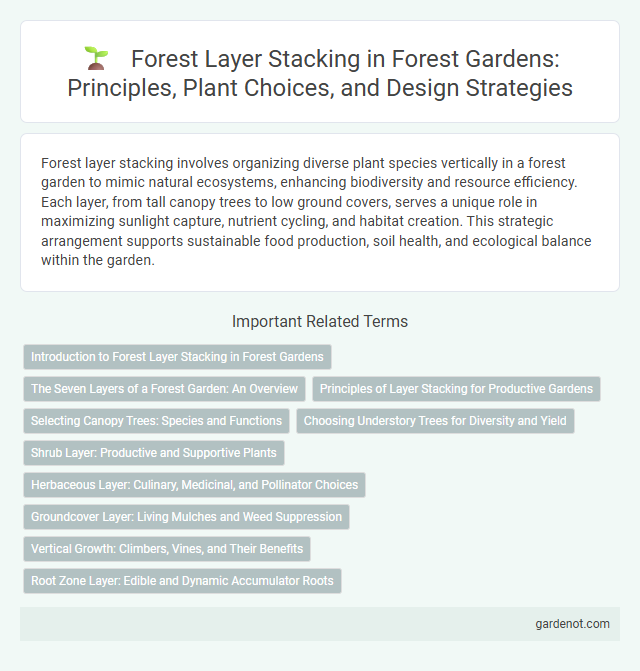Forest layer stacking involves organizing diverse plant species vertically in a forest garden to mimic natural ecosystems, enhancing biodiversity and resource efficiency. Each layer, from tall canopy trees to low ground covers, serves a unique role in maximizing sunlight capture, nutrient cycling, and habitat creation. This strategic arrangement supports sustainable food production, soil health, and ecological balance within the garden.
Introduction to Forest Layer Stacking in Forest Gardens
Forest layer stacking in forest gardens involves organizing multiple plant layers to maximize biodiversity and resource efficiency. The seven typical layers include canopy trees, low trees, shrubs, herbaceous plants, ground covers, root crops, and vines, each contributing unique ecological functions. This strategic layering enhances soil health, water management, and habitat creation while optimizing space for diverse plant species.
The Seven Layers of a Forest Garden: An Overview
The Seven Layers of a Forest Garden maximize space by mimicking natural forest ecosystems with distinct vertical strata: the canopy trees, low trees, shrubs, herbaceous plants, ground cover, root crops, and vertical climbers. Each layer contributes to biodiversity, nutrient cycling, and microclimate regulation while producing a variety of edible and useful yields. Integrating these layers enhances resilience and sustainable productivity, promoting a balanced and self-sustaining agroforestry system.
Principles of Layer Stacking for Productive Gardens
Forest garden layer stacking maximizes space by integrating seven distinct layers: canopy, sub-canopy, shrub, herbaceous, ground cover, root, and vertical layers, each contributing unique functions and yields. Effective layer stacking enhances biodiversity, improves nutrient cycling, and increases overall productivity by mimicking natural forest ecosystems. Carefully selecting complementary species in each layer optimizes light utilization and resource distribution, leading to sustainable, high-yield forest gardens.
Selecting Canopy Trees: Species and Functions
Selecting canopy trees in forest garden layer stacking involves choosing species like oak, chestnut, and black walnut for their strong shade provision and nutrient cycling capabilities. These trees serve critical ecological functions such as supporting wildlife habitats, fixing nitrogen, and enhancing soil fertility through leaf litter decomposition. Prioritizing fast-growing, drought-tolerant species improves overall garden resilience and optimizes vertical space utilization.
Choosing Understory Trees for Diversity and Yield
Selecting understory trees in a forest garden enhances biodiversity and maximizes yield by occupying vertical space efficiently beneath the canopy layer. Species like hazelnut, serviceberry, and dwarf fruit trees thrive in partial shade, contributing edible fruits, nuts, and habitat for beneficial insects. Integrating nitrogen-fixing trees such as alder improves soil fertility, supporting overall ecosystem health and productivity.
Shrub Layer: Productive and Supportive Plants
The shrub layer in a forest garden consists of productive and supportive plants like currants, gooseberries, and hazelnuts that provide fruits, nuts, and habitat for beneficial insects. These shrubs enhance soil health through nitrogen fixation and create microclimates that improve overall ecosystem resilience. Strategic layering maximizes vertical space, boosts biodiversity, and increases yield by integrating complementary species.
Herbaceous Layer: Culinary, Medicinal, and Pollinator Choices
The herbaceous layer in a forest garden includes culinary herbs like basil, thyme, and mint, which not only enhance flavors but also attract beneficial pollinators such as bees and butterflies. Medicinal plants such as echinacea, chamomile, and calendula contribute healing properties and support ecosystem health by providing habitat and nectar sources. Strategically selecting diverse, drought-tolerant herbs ensures year-round ground cover, soil enrichment, and continuous pollinator activity.
Groundcover Layer: Living Mulches and Weed Suppression
Groundcover layers in forest gardens utilize living mulches like clover, creeping thyme, and vetch to protect soil, retain moisture, and suppress weed growth naturally. These plants improve soil fertility through nitrogen fixation, enhance biodiversity, and create a microclimate favorable for tree roots and beneficial insects. Effective groundcover management reduces the need for synthetic herbicides and supports sustainable agroforestry practices.
Vertical Growth: Climbers, Vines, and Their Benefits
Forest garden layer stacking enhances vertical growth by incorporating climbers and vines that maximize space and biodiversity. These plants, such as grapevines, passionfruit, and hops, efficiently utilize vertical structures to access sunlight and improve air circulation. Their integration supports soil health through nitrogen fixation and provides habitat for pollinators and beneficial insects, boosting overall ecosystem productivity.
Root Zone Layer: Edible and Dynamic Accumulator Roots
The root zone layer in forest gardens is crucial for nutrient cycling and soil health, featuring edible roots like sweet potatoes and dynamic accumulators such as comfrey that draw minerals from deep within the soil. These plants enhance the fertility of the upper soil layers by bringing up essential nutrients, supporting the growth of other layers above. Utilizing root zone species maximizes vertical space and creates a resilient, self-sustaining ecosystem.
Forest layer stacking Infographic

 gardenot.com
gardenot.com